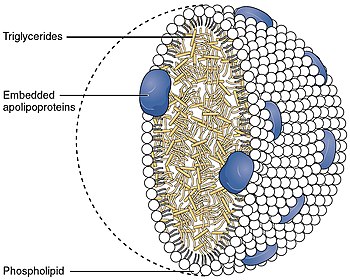APOA4
| APOA4 | |||||||||||||||||||||||||||||||||||||||||||||||||||
|---|---|---|---|---|---|---|---|---|---|---|---|---|---|---|---|---|---|---|---|---|---|---|---|---|---|---|---|---|---|---|---|---|---|---|---|---|---|---|---|---|---|---|---|---|---|---|---|---|---|---|---|
| Identifiers | |||||||||||||||||||||||||||||||||||||||||||||||||||
| Aliases | APOA4, apolipoprotein A4 | ||||||||||||||||||||||||||||||||||||||||||||||||||
| External IDs | OMIM: 107690; MGI: 88051; HomoloGene: 47927; GeneCards: APOA4; OMA:APOA4 - orthologs | ||||||||||||||||||||||||||||||||||||||||||||||||||
| |||||||||||||||||||||||||||||||||||||||||||||||||||
| |||||||||||||||||||||||||||||||||||||||||||||||||||
| |||||||||||||||||||||||||||||||||||||||||||||||||||
| |||||||||||||||||||||||||||||||||||||||||||||||||||
| Wikidata | |||||||||||||||||||||||||||||||||||||||||||||||||||
| |||||||||||||||||||||||||||||||||||||||||||||||||||
Apolipoprotein A-IV (also known as apoA-IV, apoAIV, or apoA4) is plasma protein that is the product of the human gene APOA4.[5][6]
Gene
APOA4 resides on chromosome 11 in close linkage to APOA1 and APOC3. APOA4 contains 3 exons separated by two introns, and is polymorphic, although most of the reported sequence polymorphisms occur in exon 3. The best validated and studied non-synonymous SNPs are a glutamine → histidine substitution at codon 360 and a threonine → serine substitution at codon 347; a sequence polymorphism has also been identified in the 3'UTR of the third exon.[7] Intra-species comparative gene sequence analysis suggests that the APOA4 gene arose from APOA1 by gene duplication approximately 270 MYA.[8]
Function
The primary translation product of the APOA4 gene is a 396-residue preprotein, which undergoes proteolytic processing to yield apo A-IV, a 376-residue mature O-linked glycoprotein. In most mammals, including humans, apo A-IV synthesis is confined to the intestine; however in mice and rats hepatic synthesis also occurs. Apo A-IV is secreted into circulation on the surface of newly synthesized chylomicron particles. Intestinal fat absorption dramatically increases the synthesis and secretion of apo A-IV. Although its primary function in human lipid metabolism has not been established, apo A-IV has been found to:
- activate lecithin-cholesterol acyltransferase and cholesterylester transfer protein in vitro;
- play a role in the regulation of appetite and satiety in rodent models;
- display anti-oxidant and anti-atherogenic properties in vitro and in rodent models;
- modulate the efficiency of enterocyte and hepatic transcellular lipid transport in vitro.[7]
Human apo A-IV deficiency has not been reported.
Interactions
APOA4 has been shown to interact with GPLD1.[9]
Interactive pathway map
Click on genes, proteins and metabolites below to link to respective articles. [§ 1]
- ^ The interactive pathway map can be edited at WikiPathways: "Statin_Pathway_WP430".
References
- ^ a b c GRCh38: Ensembl release 89: ENSG00000110244 – Ensembl, May 2017
- ^ a b c GRCm38: Ensembl release 89: ENSMUSG00000032080 – Ensembl, May 2017
- ^ "Human PubMed Reference:". National Center for Biotechnology Information, U.S. National Library of Medicine.
- ^ "Mouse PubMed Reference:". National Center for Biotechnology Information, U.S. National Library of Medicine.
- ^ Karathanasis SK, Oettgen P, Haddad IA, Antonarakis SE (November 1986). "Structure, evolution, and polymorphisms of the human apolipoprotein A4 gene (APOA4)". Proceedings of the National Academy of Sciences of the United States of America. 83 (22): 8457–61. Bibcode:1986PNAS...83.8457K. doi:10.1073/pnas.83.22.8457. PMC 386949. PMID 3095836.
- ^ Elshourbagy NA, Walker DW, Paik YK, Boguski MS, Freeman M, Gordon JI, Taylor JM (June 1987). "Structure and expression of the human apolipoprotein A-IV gene". J. Biol. Chem. 262 (17): 7973–81. PMID 3036793.
- ^ a b "Entrez Gene: APOA4 apolipoprotein A-IV".
- ^ Luo CC, Li WH, Moore MN, Chan L (February 1986). "Structure and evolution of the apolipoprotein multigene family". J.Mol Biol. 187 (3): 325–340. doi:10.1016/0022-2836(86)90436-5. PMID 3084795.
- ^ Deeg, M A; Bierman E L; Cheung M C (March 2001). "GPI-specific phospholipase D associates with an apoA-I- and apoA-IV-containing complex". J. Lipid Res. 42 (3). United States: 442–51. ISSN 0022-2275. PMID 11254757.
{{cite journal}}: Cite has empty unknown parameters:|laysummary=,|laydate=, and|laysource=(help)
Further reading
External links
- Apolipoprotein+A-IV at the U.S. National Library of Medicine Medical Subject Headings (MeSH)







